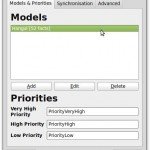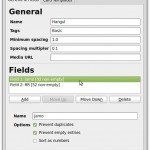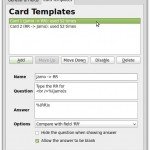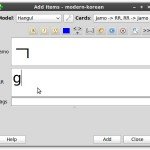Hangul and jamo practice in Anki
 One thing that sets Korean apart from other East Asia languages is it’s unique use of an entirely alphabetic writing system. For students who’ve previously studied Chinese or Japanese, this will seem like the best thing since sliced bread.
One thing that sets Korean apart from other East Asia languages is it’s unique use of an entirely alphabetic writing system. For students who’ve previously studied Chinese or Japanese, this will seem like the best thing since sliced bread.
Better still, the system is intelligently and systematically designed with very few irregularities. You can learn the rules and apply them consistently, unlike in English, where pronunciation often has to be learned by rote.
As usual, the memorisation software Anki provides an effective way to study. Korean “characters” (hangul) are composed of letters (jamo). Whilst Indo-European languages write letters in a continuous line, Korean arranges them into neat boxes, one per syllable.
Making an Anki deck for hangul
Make a model
To begin with, it’s a good idea to learn all of the jamo (letters) that spell out words in Korean. Create a new deck (ctrl + n), go to Settings → Deck Properties and rename the “Basic” model to something more meaningful.
[caption id="attachment_707” align="aligncenter” caption="Click for full size”] [/caption]
[/caption]
Name the fields
Click on Edit to configure this model. You’ll only need two fields to study jamo - the pronunciation and the jamo itself. Unfortunately there doesn’t seem to be a good source of jamo audio on the internet, so the deck will have to do without this.
[caption id="attachment_709” align="aligncenter” caption="Click for full size”] [/caption]
[/caption]
The most modern romanisation system for Korean is revised romanisation, hence the pronunciation field being named “RR”. Once that’s done, go to Card Templates to set up the flashcards.
Make some flashcard templates
With only two fields, there’s only two possible flashcard templates:
- Jamo → RR
- RR → Jamo
With each of these, the part before the arrow goes in the Question field, and the part after goes in the Answer field. For example, to make a card testing Jamo → RR, the Question field might be:
Type the RR for
%(Jamo)s
And the Answer field might be:
%(RR)s
[caption id="attachment_713” align="aligncenter” caption="Click for full size”] [/caption]
[/caption]
Once that’s finished, the model is ready to go and you can start adding material to flashcards.
Making flashcards
To make flashcards for studying jamo, you need a list of all the jamo.
Click the green cross button to add new flashcards. Then go through the list copying the information into your deck.
[caption id="attachment_716” align="aligncenter” caption="Click for full size”] [/caption]
[/caption]
And then you’ve finished! Using this deck for a few days should have your reading pretty well pinned down.
